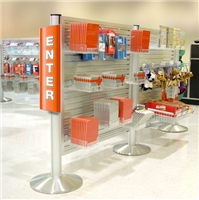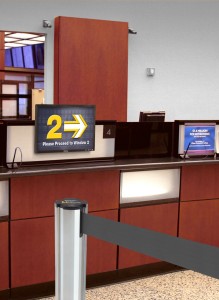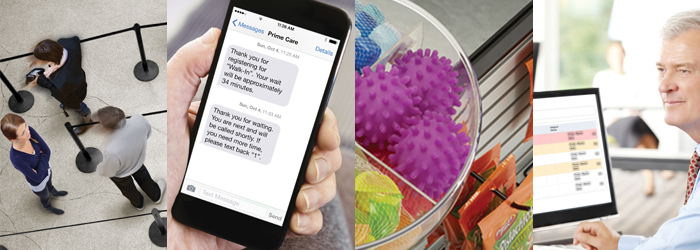Are you new to queuing and not quite sure where to start? Or perhaps you are considering adding a more formal and structured queuing system to your current retail location. Get started with these 3 simple steps to cover the important retail queuing basics:
1. Review the status quo
The first step to implementing or updating your queue is to observe your customers’ current traffic patterns. It is important to watch for any customer confusion or frustration. Is there a clear “first come, first served” rule to your queue? If not, do your customers understand why some people are being served seemingly out of order? If you don’t have a formal queue, take note of how customers assemble around the service area. Is there a method to the madness that you could take into your queuing strategy? Oftentimes, noting where service lines form naturally is a great way to make a smooth transition into a formal queuing system. Determine which direction customers most often approach the service agents and also keep in mind high and low traffic volumes, as all of these data points are important in determining your queue design.

2. Design your queue
Next, it’s time to put your observations to work. Remember the age old adage - "Measure three times, cut once” and then set off to determine how much space you have. The amount of available space will determine what kind of queue you can design. In a smaller area you may only have the space for a simple two-post queue, or, given the space, you can create a longer line and even add in-queue merchandising to the waiting area. You may have to rearrange store fixtures or other obstructions to accommodate the queue so be sure to look at the whole picture. After you have determined your space limitations, it’s time to plan the queue. This plan is a must before making any purchases. Start by determining if a single line will work for your needs or if a multiple line system is required. While studies have shown that single-line queues leading to multiple points-of-service are overall more efficient and result in lower customer wait times, it’s your job to weigh the benefits of each queue formation. The benefits of a single-line queue:
- Shorter average wait times.
- Promotes fairness by holding true to the first come, first served philosophy.
- Relieves customer stress and minimizes jockeying by eliminating the need to choose the “right line.”
- Reduces “sweethearting,” a common form of employee theft where a cashier known to the customer doesn’t scan select items as a benefit to friends or family.
The benefits of a multiple-line queue:
- Creates customer flexibility – some customers in fact like to choose where they go, so selecting the line they wait in is empowering.
- Discourages balking since waiting behind two people seems more appealing than six or more, even if the single-line format facilitates shorter wait times.
Once you have determined your line formation, map out the flow of customers through the queue paying special attention to any bottlenecks that could occur. Re-think your pattern to alleviate any of these fluctuations. Also, remember the peak traffic times you observed in step one to design expansions and short cuts to accommodate the ebb and flow of traffic.

Finally, did you determine that in-queue merchandising will be a part of your queue? If the answer is yes, consult our convenient in-line merchandising system guide. It will help you select the right products for your unique queuing needs including:
- Merchandising posts and stanchions.
- Panels that are placed between the stanchions to form the “walls” of your queue while providing a backdrop for your merchandising displays. Choose from grid walls, slat walls, in-line tables, sign frames and more.
- Product holders such as hooks, baskets, shelves and bowls.
3. Add a dose of communication

Don’t leave your queue unfinished. No matter the size or layout of your waiting line, directional signage, whether digital or static, is helpful in keeping customers informed and moving effortlessly through the queue. Post-top signs work well for queue entrances and exits. Keep these signs clear and concise to limit confusion. Taking it a step further, you can add an electronic queuing system, featuring a digital display and station lights that will direct waiting customers to the next available service point. Now you are ready to start designing your new queue and put it to work for your business. Remember to measure the performance of your queue and don't be afraid to make adjustments if necessary.













